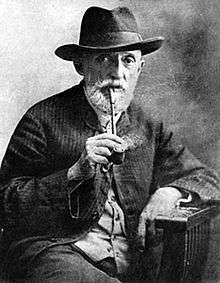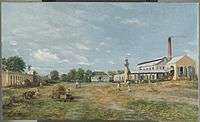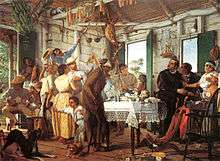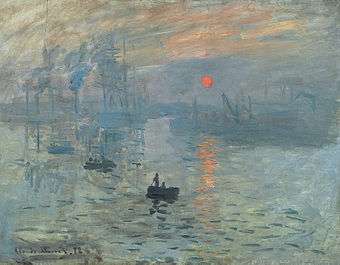Francisco Oller
| Francisco Oller | |
|---|---|
 Francisco Oller | |
| Born |
Francisco Manuel Oller Cestero June 17, 1833 Bayamon, Puerto Rico |
| Died |
May 17, 1917 (aged 83) San Juan, Puerto Rico |
| Nationality | Puerto Rican |
| Education | Royal Academy of San Fernando, Thomas Couture, Gustave Courbet |
| Known for | Painting |
| Movement | Impressionism |
| Patron(s) | Museo de Arte de Ponce[1] |
Francisco Oller (June 17, 1833 – May 17, 1917) was a Puerto Rican visual artist. Oller is the only Latin American painter to have played a role in the development of Impressionism.
Biography
Early years
Oller (birth name: Francisco Manuel Oller y Cestero [note 1]) was born in Bayamón, Puerto Rico, the third of four children of aristocratic and wealthy Spanish parents Cayetano Juan Oller y Fromesta and María del Carmen Cestero Dávila.[2][3] When he was eleven he began to study art under the tutelage of Juan Cleto Noa, a painter who had an art academy in San Juan, Puerto Rico. There, Oller demonstrated that he had an enormous talent in art and in 1848, General Juan Prim, Governor of Puerto Rico, offered Oller the opportunity to continue his studies in Rome. However, the offer was not accepted as Oller's mother felt that he was too young to travel abroad by himself
When Oller was eighteen, he moved to Madrid, Spain, where he studied painting at the Royal Academy of San Fernando, under the tutelage of Don Federico de Madrazo y Kuntz, director of the Prado Museum. In 1858, he moved to Paris, France where he studied under Thomas Couture. Later he enrolled to study art in the Louvre under the instruction of Gustave Courbet.[4] During his free time, Oller, who had a baritone type of singing voice, worked and participated in local Italian operas. He frequently visited cafés where he met with fellow artists. He also became a friend of fellow Puerto Ricans Ramón Emeterio Betances y Alacán and Salvador Carbonell del Toro, who were expatriates in France because of their political beliefs. In 1859, Oller exhibited some of his artistic works next to those of Bazille, Renoir, Monet, and Sisley.[4]
For a short time, Paul Cézanne was one of Oller's students, although their professional relationship deteriorated with time. By 1865, Oller was known as the first Puerto Rican and Hispanic Impressionist artist. In 1868, he founded The Free Academy of Art of Puerto Rico.
Later years
In 1884, he founded an art school for young women[5] which was later to be known as the Universidad Nacional. In 1871, Spain honored Oller by naming him a member of the Caballeros de la Orden de Carlos III (which translates to Knighthood of the Order of Carlos III), and a year later he became the official painter of the Royal Court of Amadeo I. Oller developed an interest in bringing out the reality of Puerto Rico's landscape, its people, and culture through his works of art. Oller's paintings can be found in museums worldwide, including the Louvre in France.
Francisco Oller died on May 17, 1917 in San Juan, Puerto Rico.
Styles and influences
Oller was a prolific painter with works ranging in topic from still-lifes and landscapes to historical events and portraiture.[5] While he was involved with several painting movements, Realism, Naturalism and Impressionism;[5] he is best known for his Impressionist works.[5]
Selected works
- El pleito de la herencia (1854–1856)
- Retrato de Manuel Sicardó (1866–1868)
- El Estudiante (1874)
- Las lavanderas (1887–1888)
- La Escuela del Maestro Rafael Cordero (1890–1892)
- El Velorio ("The Wake") (1893)[5]
- Bodegón con piñas
- El Cesante
- Hacienda La Fortuna de Ponce (1885)[6][7]
Legacy and remembrance
The town of Cataño in Puerto Rico, named a high school after him and the City of New York renamed P.S.61 in The Bronx P.S. Francisco Oller. There is also a Francisco Oller Library in the Escuela de Artes Plásticas (School of Plastic Arts) in San Juan. The Francisco Oller Museum where many artists, such as Tomás Batista, exhibit their work is located in the city of Bayamón. In Buffalo, New York there is a Francisco Oller and Diego Rivera Museum of Art where Manuel Rivera-Ortiz and other artists have exhibited their work.
Gallery
-

Hacienda La Fortuna, 1885. Brooklyn Museum
-

La Escuela del Maestro Rafael Cordero (1890–1892)
-

El Velorio (1893)
-

Estudio del Natural, (1866-72)[1]
- ^ "El pañuelo de la negra: notas sobre la construcción artesanal de la memoria" (PDF). Retrieved January 27, 2016.
See also
Notes
- ↑ This name uses Spanish naming customs: the first or paternal family name is Oller and the second or maternal family name is Cestero.
References
- ↑ "Feature Exhibition: Mi Puerto Rico". Newark Museum. Retrieved July 10, 2012.
- ↑ Catalogue Commemorating the Exhibition the Art Heritage of Puerto Rico: Pre .. By Museo del Barrio (New York, N.Y.), Metropolitan Museum of Art (New York, N.Y.)
- ↑ http://nobox.net/voz/prog_216.mp3 (Spanish) "Oller en Europa": Haydée Venegas' interview by La Voz del Centro
- 1 2 Raynor, Vivien (February 10, 1984). "Francisco Oller, Puerto Rico Glimpsed". The New York Times.
|section=ignored (help) - 1 2 3 4 5 Spiegelman, Willard (8 July 2015). "A Voyager Among Countries and Styles". The Wall Street Journal. p. D5., electronic copy published as Spiegelman, Willard (7 July 2015). "'Impressionism and the Caribbean: Francisco Oller and His Transatlantic World' Review". The Wall Street Journal. Archived from the original on 13 July 2015.
- ↑ Collazo, Edwin Velázquez (17 June 2012). ""Hacienda Fortunata" (sic) de Francisco Oller a la colección del Brooklyn Museum". arte coa / arte de puerto rico y el caribe: Revista Digital de Arte Caribeño, Contemporáneo e Internacional. Archived from "Hacienda_Fortunata"_de__Francisco_Oller_a_la_colección_del_Brooklyn_Museum the original on 7 April 2014.
- ↑ Photograph - PONCE - A Sugar Refinery or Plantation near City of Ponce, P. R. circa 1898. [Identified by a viewer as Hacienda La Matilde] - Vintage Photo measures 7 x 5 inches. Flickr. Retrieved 5 September 2013.
Further reading
- The art heritage of Puerto Rico, pre-Columbian to present. New York: The Metropolitan Museum of Art and El Museo del Barrio. 1973.
